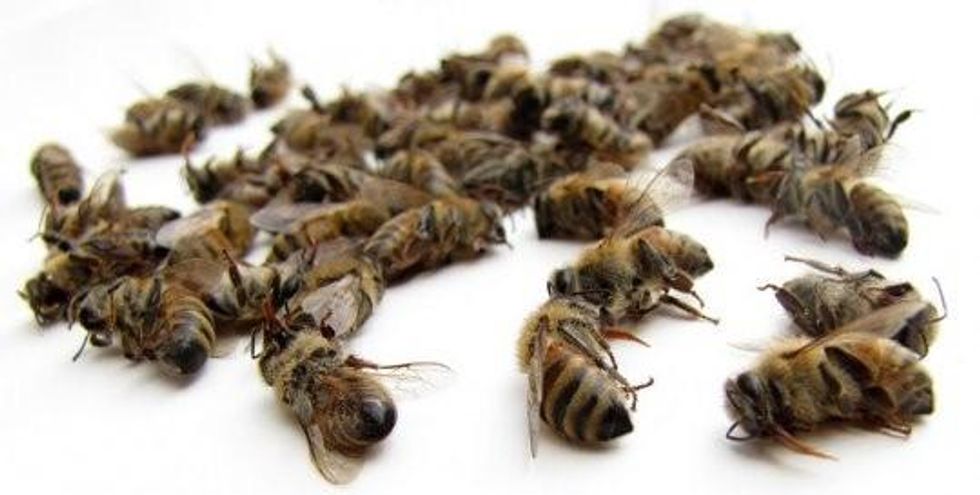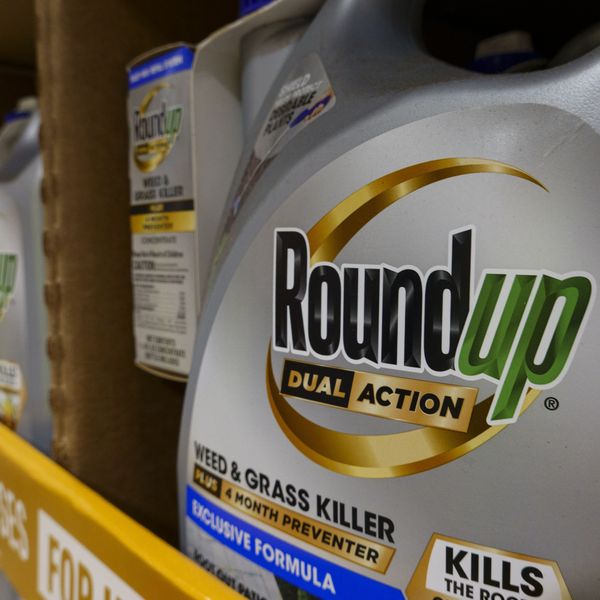Record Cold Winter Wallops Already Struggling Bees
"When I came out and saw my loss, I mean you literally just cry."

While they expect to lose a small proportion of their hives each year, Iowa beekeepers say this year their losses are far beyond normal ranges.
"It's devastating," Mike Swett of Squaw Creek Honey told local Iowa station KCCI. "When I came out and saw my loss, I mean you literally just cry."
Iowa Department of Agriculture bee researcher Andrew Joseph says the losses could be as high as 70 percent, compared to an average winter loss of up to 20 percent.
The high losses, he explains, were the result of not just the frigid temperatures on their own but of the multiple threats bees were already facing that left them more vulnerable.
Alison Sullivan reports:
Iowa Department of Agriculture bee researcher Andrew Joseph characterized the situation as a "death by a thousand paper cuts" as the honey bee population has faced an environment lacking in diversity, pesticide problems, colony collapse and parasites such as varroa mites, since the 1990s. [...]
"It's not that bees can't handle a cold winter or snow ... (but) when you go into winter with those types of bees and then you're confronted with the harshness of this season, they don't make it through to spring time," Joseph said.
Dave Irvin, President of the East Central Iowa Beekeepers, echoed these points, and told Common Dreams his association reported losses as high as 80 percent -- a range "way out" of what normally happens.
The cold is part of it, Irvin said, but it also has to do with the diseases and chemicals bees are confronting.
To help beekeepers now facing these expensive losses, he urges people to buy more bees, and to be aware of the chemical assault they may be waging on their lawns and crops.
___________________
An Urgent Message From Our Co-Founder
Dear Common Dreams reader, The U.S. is on a fast track to authoritarianism like nothing I've ever seen. Meanwhile, corporate news outlets are utterly capitulating to Trump, twisting their coverage to avoid drawing his ire while lining up to stuff cash in his pockets. That's why I believe that Common Dreams is doing the best and most consequential reporting that we've ever done. Our small but mighty team is a progressive reporting powerhouse, covering the news every day that the corporate media never will. Our mission has always been simple: To inform. To inspire. And to ignite change for the common good. Now here's the key piece that I want all our readers to understand: None of this would be possible without your financial support. That's not just some fundraising cliche. It's the absolute and literal truth. We don't accept corporate advertising and never will. We don't have a paywall because we don't think people should be blocked from critical news based on their ability to pay. Everything we do is funded by the donations of readers like you. Will you donate now to help power the nonprofit, independent reporting of Common Dreams? Thank you for being a vital member of our community. Together, we can keep independent journalism alive when it’s needed most. - Craig Brown, Co-founder |

While they expect to lose a small proportion of their hives each year, Iowa beekeepers say this year their losses are far beyond normal ranges.
"It's devastating," Mike Swett of Squaw Creek Honey told local Iowa station KCCI. "When I came out and saw my loss, I mean you literally just cry."
Iowa Department of Agriculture bee researcher Andrew Joseph says the losses could be as high as 70 percent, compared to an average winter loss of up to 20 percent.
The high losses, he explains, were the result of not just the frigid temperatures on their own but of the multiple threats bees were already facing that left them more vulnerable.
Alison Sullivan reports:
Iowa Department of Agriculture bee researcher Andrew Joseph characterized the situation as a "death by a thousand paper cuts" as the honey bee population has faced an environment lacking in diversity, pesticide problems, colony collapse and parasites such as varroa mites, since the 1990s. [...]
"It's not that bees can't handle a cold winter or snow ... (but) when you go into winter with those types of bees and then you're confronted with the harshness of this season, they don't make it through to spring time," Joseph said.
Dave Irvin, President of the East Central Iowa Beekeepers, echoed these points, and told Common Dreams his association reported losses as high as 80 percent -- a range "way out" of what normally happens.
The cold is part of it, Irvin said, but it also has to do with the diseases and chemicals bees are confronting.
To help beekeepers now facing these expensive losses, he urges people to buy more bees, and to be aware of the chemical assault they may be waging on their lawns and crops.
___________________

While they expect to lose a small proportion of their hives each year, Iowa beekeepers say this year their losses are far beyond normal ranges.
"It's devastating," Mike Swett of Squaw Creek Honey told local Iowa station KCCI. "When I came out and saw my loss, I mean you literally just cry."
Iowa Department of Agriculture bee researcher Andrew Joseph says the losses could be as high as 70 percent, compared to an average winter loss of up to 20 percent.
The high losses, he explains, were the result of not just the frigid temperatures on their own but of the multiple threats bees were already facing that left them more vulnerable.
Alison Sullivan reports:
Iowa Department of Agriculture bee researcher Andrew Joseph characterized the situation as a "death by a thousand paper cuts" as the honey bee population has faced an environment lacking in diversity, pesticide problems, colony collapse and parasites such as varroa mites, since the 1990s. [...]
"It's not that bees can't handle a cold winter or snow ... (but) when you go into winter with those types of bees and then you're confronted with the harshness of this season, they don't make it through to spring time," Joseph said.
Dave Irvin, President of the East Central Iowa Beekeepers, echoed these points, and told Common Dreams his association reported losses as high as 80 percent -- a range "way out" of what normally happens.
The cold is part of it, Irvin said, but it also has to do with the diseases and chemicals bees are confronting.
To help beekeepers now facing these expensive losses, he urges people to buy more bees, and to be aware of the chemical assault they may be waging on their lawns and crops.
___________________

